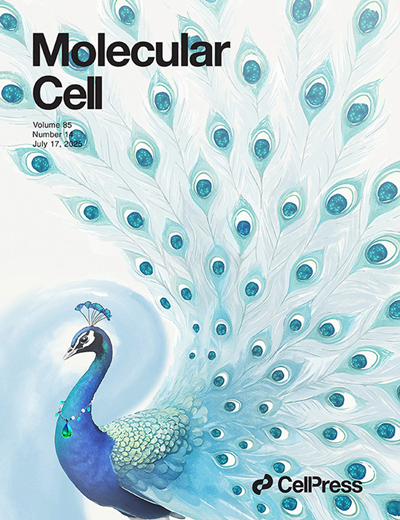
《Volume 85,Issue 14p2627-2812,July 17, 2025》
Chenyun Dai 1,2,3,4 ∙ Yuangui Tang1,4 ∙ Huihui Yang 1 ∙ Junfang Zheng 1,5
The cover of this issue of Molecular Cell features the study “YTHDC1 lactylation regulates its phase separation to enhance target mRNA stability and promote RCC progression” by Chenyun Dai¹²³⁴, Yuangui Tang¹⁴, Huihui Yang¹, and Junfang Zheng¹⁵ from the School of Basic Medical Sciences, Capital Medical University.

Research Background
Renal cell carcinoma (RCC) is characterized by a unique tumor microenvironment that is both hypoxic and enriched in lactate. This distinctive microenvironment creates highly favorable conditions for aberrant intracellular lysine lactylation (Kla). Although it is known that the microenvironment of RCC is closely associated with the occurrence of Kla, the functional role of Kla in RCC initiation and progression, as well as its underlying molecular mechanisms, has remained unclear, representing a key scientific question in urgent need of resolution in this field.
Research Significance
This study holds important significance at multiple levels.
First, through systematic investigation, we demonstrated that global Kla levels are markedly elevated in human RCC tissues and cells, and that this elevation is directly associated with malignant progression of RCC. These findings provide a new perspective for understanding the pathogenesis of RCC and reveal that changes in Kla levels may serve as an important indicator of RCC malignancy.
Second, by applying advanced lactyl-proteomic analysis to human RCC cells under hypoxia-mimicking conditions, we identified lysine lactylation at the K82 site of the m^6A reader protein YT521-B homology (YTH) domain-containing protein 1 (YTHDC1). Further experiments revealed that this p300-mediated YTHDC1^K82la modification robustly promotes RCC malignant progression both in vitro and in vivo, identifying a novel key molecular target involved in RCC pathogenesis and deepening our understanding of its disease mechanisms.
Third, at the mechanistic level, we found that YTHDC1^K82la enhances the phase separation capacity of YTHDC1, leading to the expansion of nuclear condensates. This alteration protects oncogenic transcripts such as BCL2 and E2F2 from degradation by the poly(A) tail exosome targeting (PAXT)–exosome complex, thereby increasing the stability of YTHDC1 target mRNAs. This discovery delineates a complete signaling pathway in which Kla regulates gene expression through modulation of phase separation, ultimately driving RCC progression, and greatly enriches our understanding of the molecular mechanisms underlying RCC development.
Finally, our study offers new hope and directions for RCC clinical therapy. Based on the critical role of Kla modification and YTHDC1 in RCC progression, novel therapeutic strategies targeting either the Kla modification process or YTHDC1 phase separation could be developed in the future, providing new avenues for improving patient outcomes.
Research Outlook
In future investigations, several promising directions merit further exploration.
On one hand, research can focus on the dynamic regulatory mechanisms of Kla modification—examining how Kla levels change under different physiological and pathological conditions, and identifying the key enzymes and signaling pathways involved. A comprehensive understanding of Kla dynamics will allow more precise determination of its timing and mode of action during RCC initiation and progression.
On the other hand, the regulatory network of YTHDC1 phase separation warrants deeper study. In addition to the Kla modification identified here, other factors—such as additional post-translational modifications or protein–protein interactions—may also participate in regulating this process. Constructing a complete regulatory network for YTHDC1 phase separation will further elucidate its central role in gene expression control.
Moreover, given the critical role of Kla and YTHDC1 in RCC progression, targeted drug development has substantial translational potential. Screening for small molecules or biologics that specifically inhibit Kla modification or disrupt YTHDC1 phase separation, followed by preclinical and clinical evaluation, could yield new therapeutic options for RCC patients.
Lastly, considering the pivotal role of Kla in RCC, it is plausible that Kla may exert similar functions in other cancer types. Investigating Kla expression patterns, functional roles, and mechanisms across diverse cancers could provide theoretical foundations and novel therapeutic targets for broader oncological applications, ultimately advancing the overall field of cancer therapy.
Cover design process
The cover design features a peacock as the central motif, using its uniqueness and splendor as a metaphor for the journal’s excellence and leading edge in the field of molecular cell biology. The peacock’s fully fanned tail feathers create a striking visual impact, symbolizing the brilliant blossoming and far-reaching influence of scientific achievements. Just as a peacock’s display draws attention, it captures readers’ interest in the journal’s content. At the same time, the peacock’s imagery echoes the paper’s exploration of intricate intracellular regulatory mechanisms, suggesting that the delicate and exquisite networks inside a cell resemble the fine patterns of a peacock’s tail.
The overall palette adopts a fresh, high-tech blue-and-white tone. The peacock’s body is primarily blue, while its tail feathers are predominantly white, adorned with blue-green eyespot patterns. Blue is often associated with technology, rationality, and depth, aligning with Molecular Cell’s rigor and professionalism as a scientific journal. White conveys purity and simplicity, giving the composition a clean, crisp look that highlights the subject. The blue-green eyespots add liveliness and vibrancy to the image, breaking the potential monotony of a single color scheme while symbolizing novel discoveries and unique perspectives in scientific research.
The cover as a whole is rendered in an illustrative style, blending art and science. By combining realism with artistic stylization, the design preserves the authentic form of the peacock while enhancing it with expressive colors and lines. This approach avoids the stiffness that pure realism might bring, as well as the ambiguity that could arise from excessive abstraction—successfully attracting readers’ attention while conveying the journal’s dual qualities of scientific rigor and creative artistry.
Our hours
Beijing time: 9:00-18:00